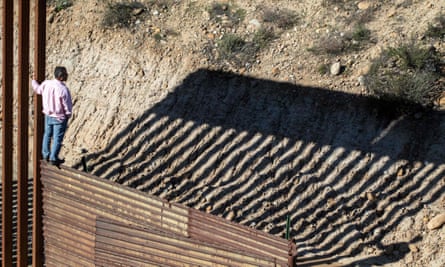Donald Trump’s frenzied preoccupation with expanding the wall on the US-Mexico border that, two years into his presidency has yet to materialize, often eclipses the very real “invisible wall” he has constructed to exclude immigrants.
Trump has taken the extreme step of threatening to declare a national emergency if Democrats will not approve his $5.7bn demand for the project.
At the same time, his administration has successfully made it more difficult for immigrants to enter the country to work, visit family and flee violence and poverty.
As Trump continues to demand an expansion of the barrier with Mexico, rightwing anti-immigrant groups that advocate harsh restrictions on immigration , such as the Federation for American Immigration Reform (Fair), are looking back on two years of what they consider significant progress.
At least six current and former advisers to Donald Trump, including Kellyanne Conway and Stephen Miller, have ties to Fair, which for decades has been working to drastically curb immigration.
“A lot of his [Trump’s] accomplishments are more granular, more in the weeds, than build the wall,” RJ Hauman, Fair’s head lobbyist, told the Guardian.
Last year, radical changes to US immigration policy included separating 2,654 migrant children from their parents at the border, slashing the refugee limit to a historic low of 30,000 people allowed to settle in the US, and adding a citizenship question to the population census, a move that is being challenged in court.
These high-profile maneuvers happened in concert with many less headline-grabbing but key administrative changes to the legal immigration process. These toughened rules for immigrants and increased visa processing times, such as a proposal to make it more difficult for people to get green cards if they use public benefits.
For groups such as Fair, these changes are exactly why Trump has been a success. “Those legal immigration changes are just as important, or even more important, than building the wall right now and we wish they were more of a focus in this current negotiation,” Hauman said.
The Fairwebsite lists 10 campaign promises Trump made and information on whether or not he has completed them. As of this week, Trump had completed one promise: the travel ban, ordered days into his presidency, which was affirmed by the supreme court after being amended twice. Five of the other promises are in progress, three have been initiated and one has been stalled, according to the Fair website.
Hauman said he expects the Trump administration will keep making administrative changes that do not require congressional approval, but have a significant impact on immigration. This year, for instance, the government plans to cancel a regulation that allows spouses of people with H-1B temporary specialist work visas to obtain work permits themselves. This would revoke more than 100,000 people’s ability to work legally in the US, unless a court intervenes.
With Democrats seizing control of the House after strong gains in the midterm election in November, it is more difficult for immigration hardliners to push legislation through Congress. So, the most expedient route to restrict immigration is by working with government agencies to change administrative policies or forcing policies through by presidential executive orders, such as the attempt in November to stop people from seeking asylum when entering the US outside the official ports of entry dotted along the southern border.

Each change is being closely monitored by immigrant and civil rights groups, such as the American Civil Liberties Union (ACLU), which has led dozens of legal campaigns against Trump policies. A day after the administration announced the so-called asylum ban, the ACLU had filed a lawsuit against it. One month later, the supreme court upheld a lower court’s decision to block the ban.
“There are legal constraints to what the government can do and those constraints have stopped many things from moving forward,” said Omar Jadwat, director of the Immigrants’ Rights Project at the American Civil Liberties Union (ACLU). “But that hasn’t stopped them from trying.”
Jadwat said even immigration experts struggle to keep track of the government’s endless stream of policy changes, directives and behind-the-scenes maneuvers to reshape immigration policy.
“It is all really part of one campaign to target immigrants and immigration,” said Jadwat. “To do everything they can, and many things they can’t legally do, to try to vilify immigrants, to make their lives harder, both people who are in status and people who are seeking legal status.”
The ACLU’s legal challenges have stopped, or slowed, several Trump policies from continuing, including forcing the government to reunify families it separated at the border last summer – months before mass separations began.
Despite this, they are bracing for another two years of Trump administration anti-immigration policies, which could include another form of family separation.
In November, Trump’s nominee to run US Immigration and Customs Enforcement (Ice), Ronald Vitiello, declined to rule out the possibility that the US could again separate families at the border. And the Trump administration has reportedly weighed family separation alternatives including a “binary choice” plan that would give parents the option to separate voluntarily or be detained together for years.
Jadwat concluded: “They have doubled and tripled down on these policies that are illegal and unconscionable. And done it in ways, and repeatedly, that are extremely sloppy [and] lack the basic competence you would expect from the government.”
